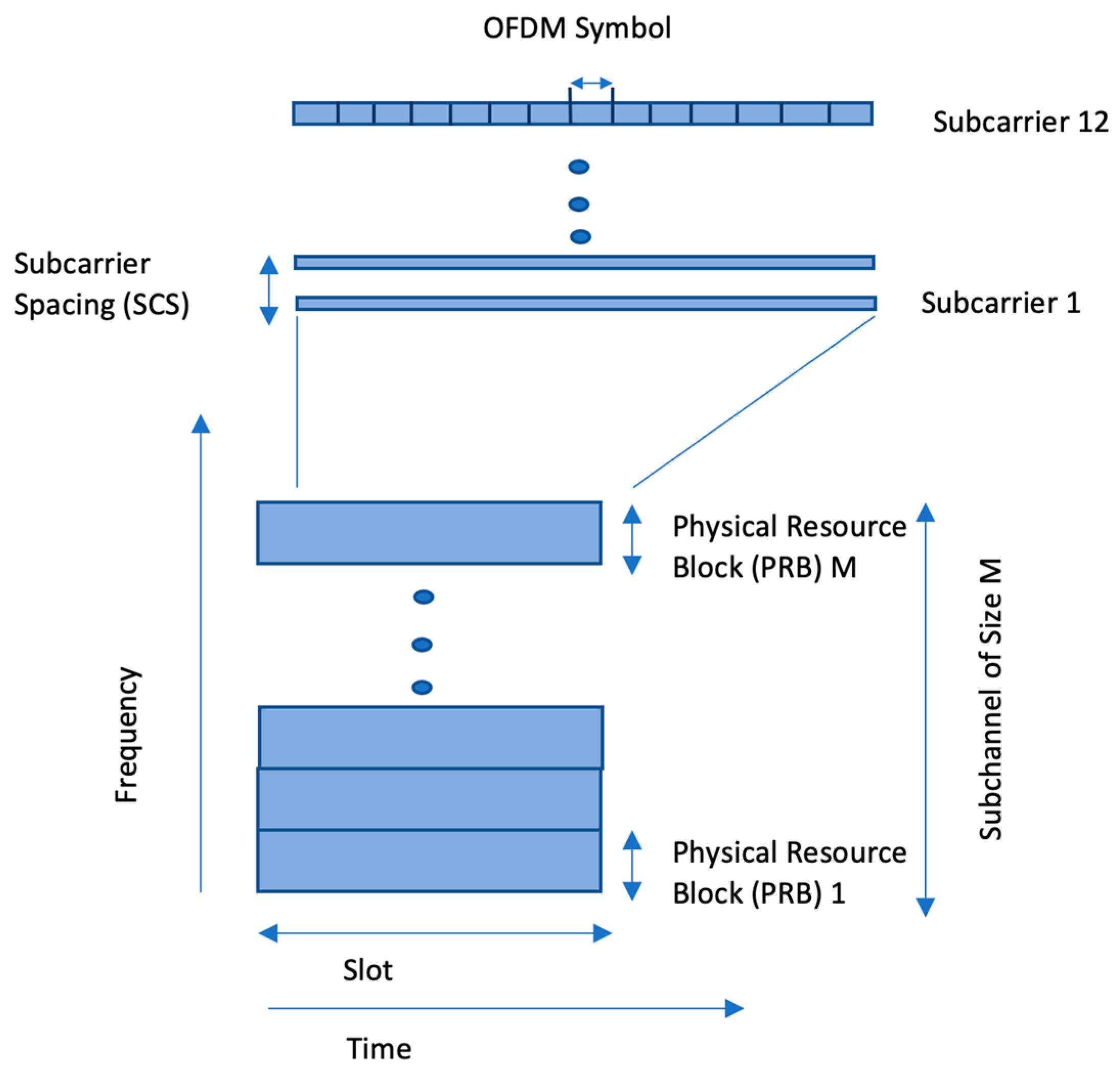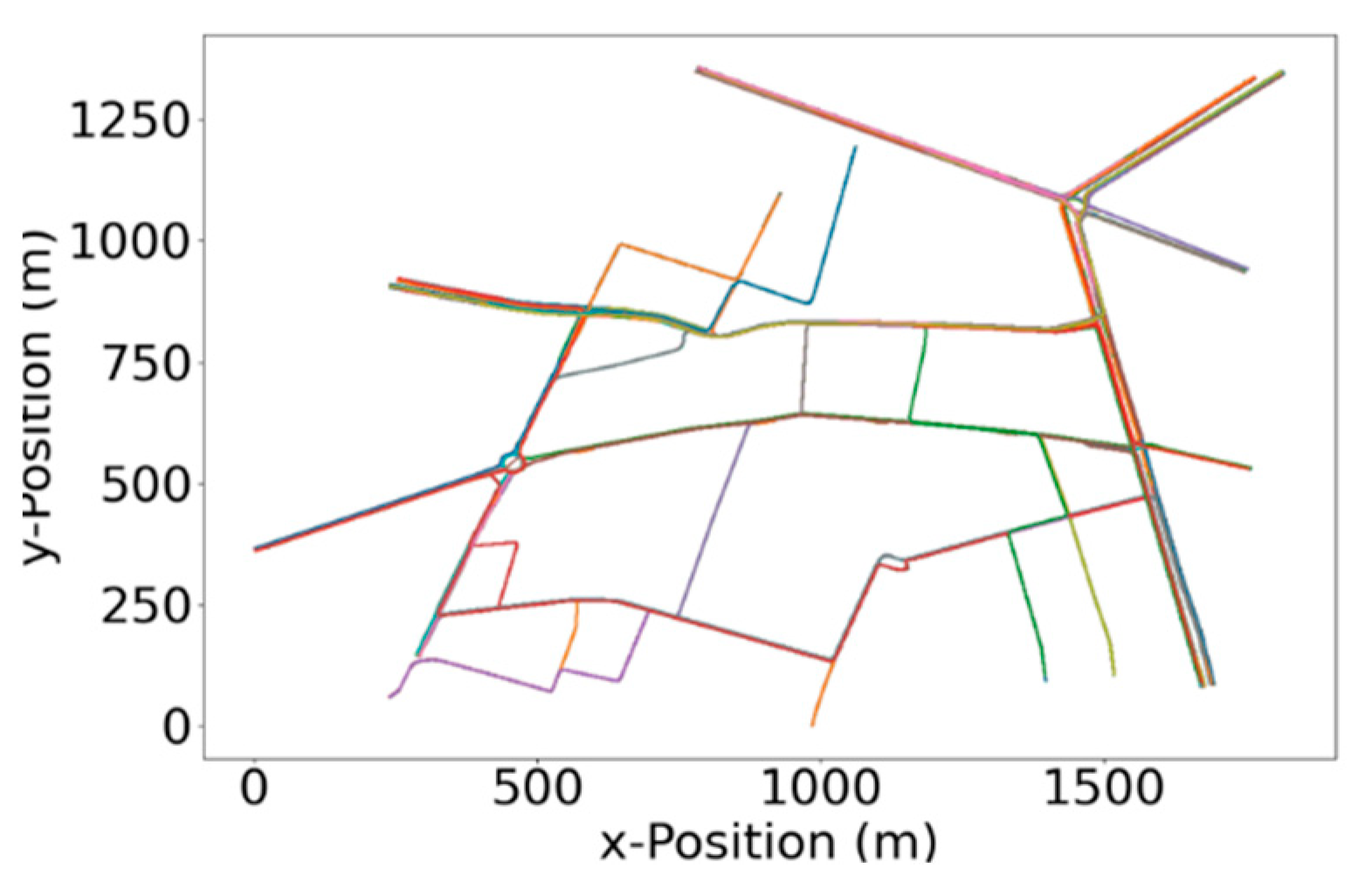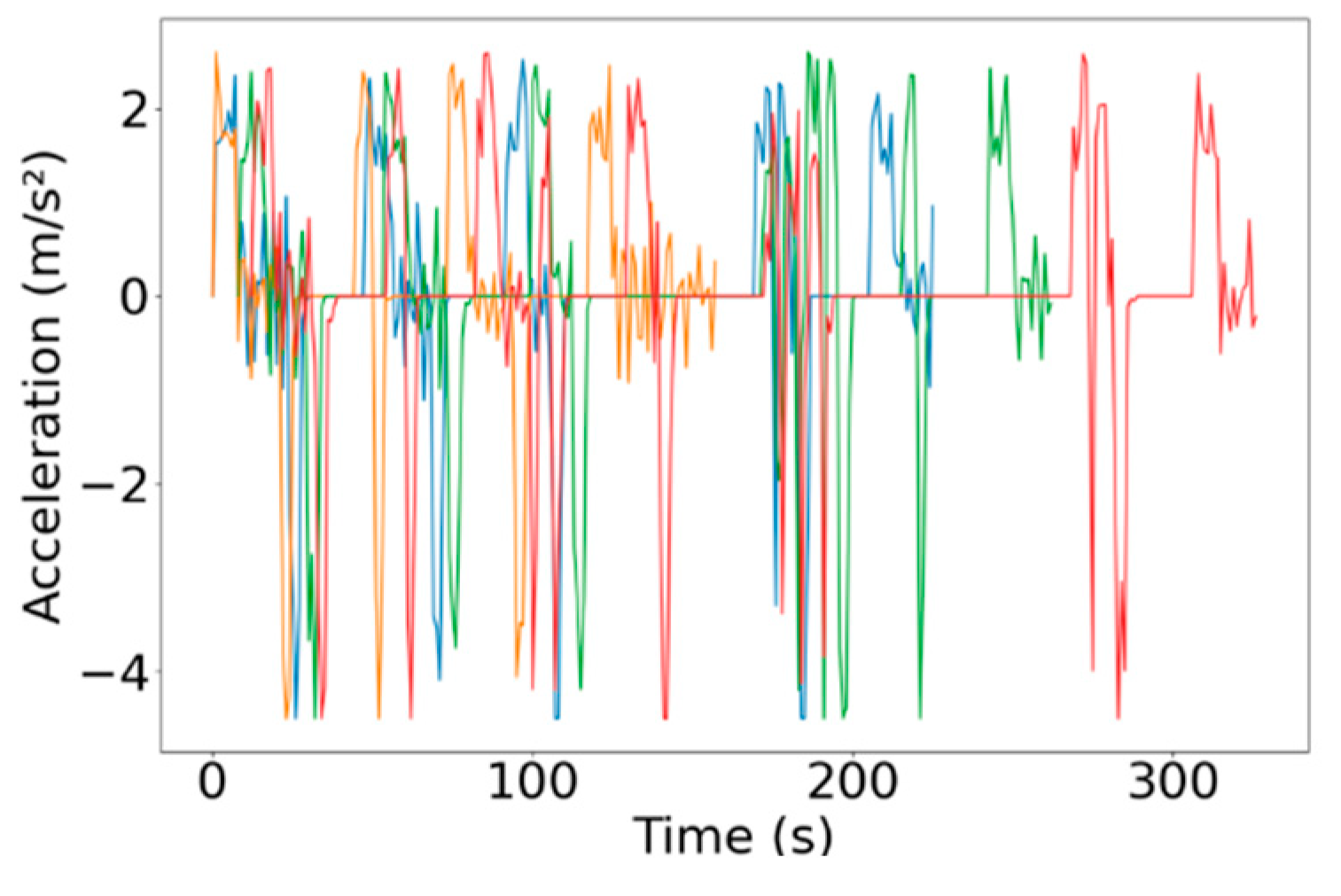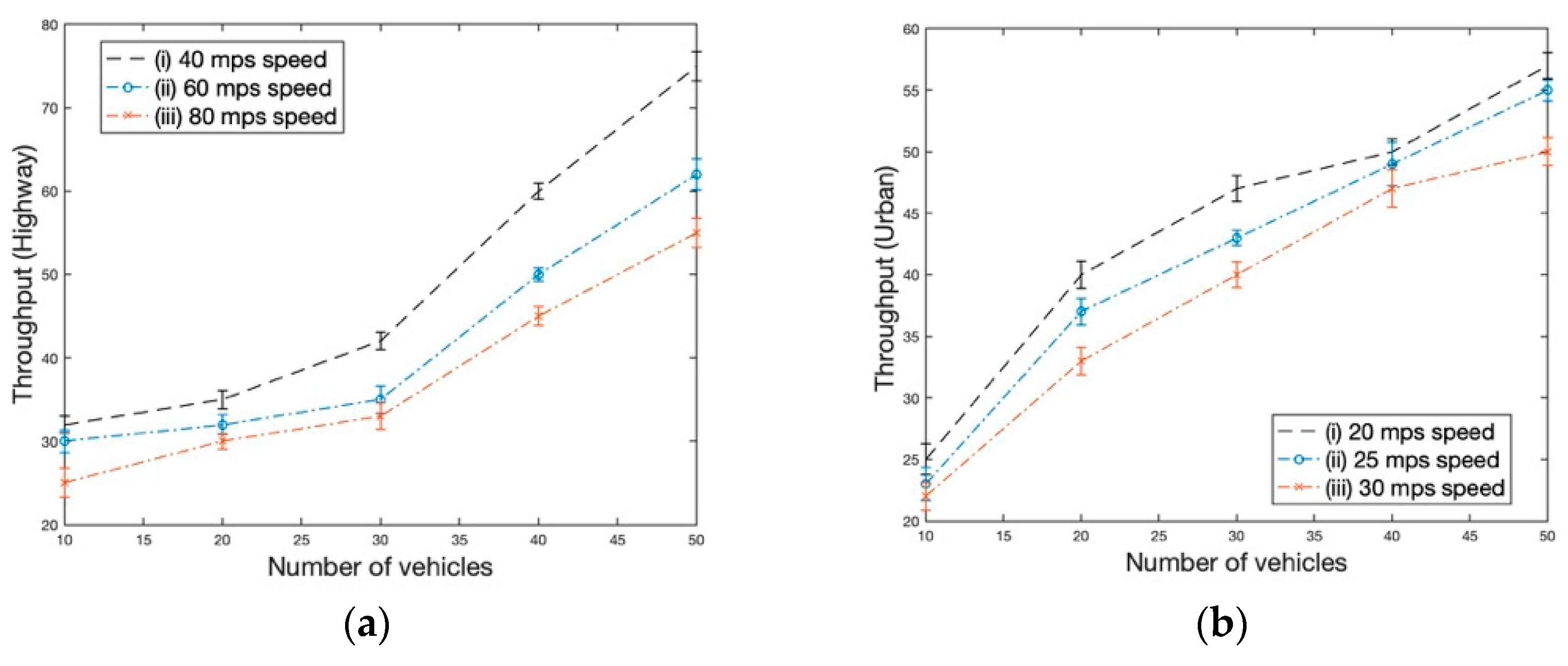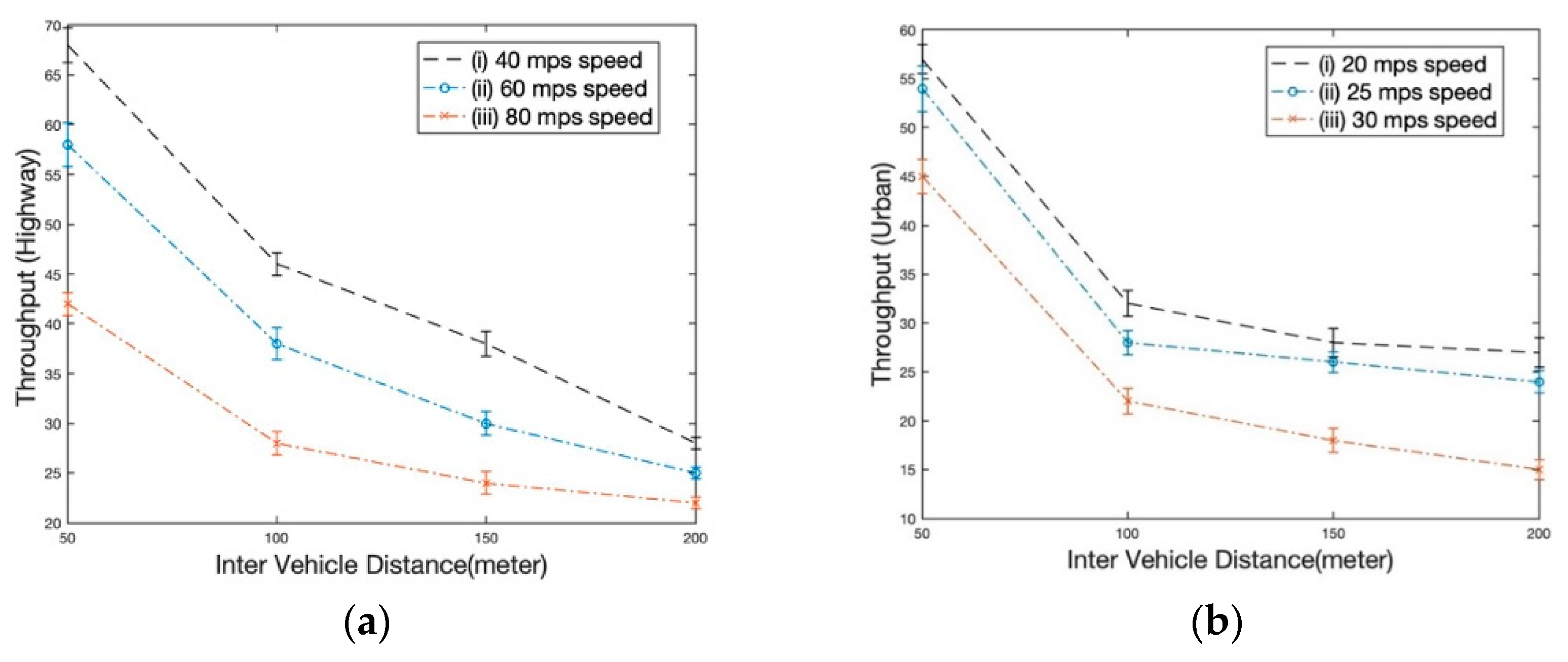1. Introduction
The aim of connected and autonomous vehicles is to improve traffic flow, reduce fatalities on the road, and reduce the environmental impact of modern mobility, among others [
1]. Vehicle to Everything (V2X) communication, by offering minimal latency and high dependability [
2,
3], allows for the sharing of different types of information (e.g., traffic, entertainment, and safety) with other vehicles, pedestrians, and infrastructures deployed in the road through wired/wireless networks. V2X communication is comprised of various types of communication, including vehicle-to-vehicle (V2V), vehicle-to-infrastructure/network (V2I/N), and vehicle-to-pedestrian (V2P) [
4].
The 3GPP C-V2X technology, in accordance with the fifth generation (5G) NR, ensures higher efficient connectivity [
5]. Up until now, significant resources have been put into enhancing the efficiency of direct V2V communications using the sidelink interface, which allows for network infrastructure bypass [
6]. In order to facilitate low latency V2X communications, 3GPP release version 14 added two additional sidelink transmission modes: Modes 3 and 4 (shown in
Figure 1) [
7]. In addition to C-V2X Mode 3 and Mode 4, two more sidelink resource allocation NR Modes (1, 2) are now available. In 3GPP Release 16, Mode 1 refers to the network’s-controlled allocation of Radio Resources (RR)s for sidelink communications. In 3GPP Release 16 Mode 2, individual vehicles can choose their own RRs using a distributed process [
8].
The undergoing NR V2X specifications in Release 16 [
9] includes many enhancements to the C-V2X standard, affecting both the conventional Uu (uplink unicast) cellular interface and the sidelink PC5 interface enabling direct V2V connectivity. NR Mode 1 is also known as a network-controlled mode. In this Mode, the base station schedules resources for vehicular UEs to use for sidelink communications. Similar to Mode 3 in Release 14, Mode 1 only applies to in- coverage conditions. In NR Mode 2 (also known as user equipment autonomous), the network preconfigures a set of sidelink red scenarios, and UEs independently choose how to use them. Similar to Mode 4 in Release 14, Mode 2 can be used in both in-coverage and out-of-coverage scenarios. The main focus of this work is on Mode 2 [
10]. Mode 2 follows the sensing-based Semi Persistent Scheduling (SPS) technique described in Release 14. Using this approach, UEs can detect the channel before transmission to select the resources that are less likely to be interfered with and possibly reserve them for a random number of subsequent messages.
2. Background
2.1. Cellular V2X (C-V2X)
C-V2X is based on 3GPP Release 14 specification and ensures better performance than IEEE 802.11p [
11]. The widespread cellular infrastructure that already exists can benefit C-V2X users. As it was not always possible to rely on the presence of cellular infrastructure, C-V2X offers transmission modes that enable direct V2XV2X communications through sidelink channel via PC5 interface [
12]. C-V2X has a basic time-frequency resource structure where the smallest unit of allocation in time is a sub-frame (1 msec made up of 14 OFDM symbols) and the smallest frequency granularity is 12 sub-carriers of 15 kHz each (total of 180 kHz). C-V2X devices can transmit utilizing 16-Quadrature Amplitude Modulation (QAM) or Quadrature Phase Shift Keying (QPSK) schemes with turbo coding in each Orthogonal Frequency-Division Multiplexing (OFDM) subcarrier [
7,
12].
C-V2X users also transmit control information and reference signals in addition to data symbols. One of these signals, the Demodulation Reference Signal (DMRS), is utilized for channel estimation. Two out of fourteen OFDM symbols used in Long-Term Evolution (LTE) have DMRS symbols integrated into them, and those four DMRS symbols are placed in a C-V2X sub-frame since C-V2X is built for high-mobility settings [
14]. C-V2X can use both the conventional LTE interface and the sidelink interface to function with BSs present in the network or without any BS.
2.2. 5G-V2X
5G-V2X uses Single Carrier Frequency Division Multiple Access (SCFDMA) at the Medium Access Control (MAC) layer and OFDM at the physical layer, whereas 5G-V2X sidelink transmissions use Cyclic Prefix Orthogonal Frequency- Division Multiplexing (CPOFDM), which excels in high spectral and throughput efficiency as well as latency. It is also more resistant to frequency doppler shift and oscillator phase noise than other multi-carrier waveforms. With the adoption of various modulation formats in 5G-V2X, such as QPSK, 16-QAM, 64-QAM, and 256-QAM with binary reflected Gray mapping, high-order modulations can now have increased spectral efficiency and throughput at the expense of sidelink coverage [
15].
The 5G-V2X RRs at the physical (PHY) layer include the time and frequency domain [
4]. In the time domain, RRs are arranged in frames and subframes with set durations of 10 ms and 1 ms, respectively. When the conventional cyclic prefix is used, each subframe is divided into one or more slots, each of which is made up of 14 OFDM symbols. Physical resource block (PRB)s, subchannels, and RRs are arranged in the frequency domain. K consecutive PRBs make up a subchannel, and K can be any number between 10, 12, 15, 20, 25, 50, 75, or 100. 12 consecutive subcarriers with subcarrier spacing make up a PRB(SCS). In
Figure 2, we illustrate time and frequency domains, the relationship between Resource Block (RB)s, subcarrier, PRB, and subchannel.
2.3. Overview of Sidelink Technology
Sidelink is a cellular technology that offers direct communication between de- vices with or without cellular BS assistance. The 3GPP has been exploring sidelink technology since their release 12 [
17]. Especially dedicated physical layer channels have been designed to support device discovery, synchronization, and sidelink transmission. These channels include Physical Sidelink Shared Channel (PSSCH), Physical Sidelink Control Channel (PSCCH), Physical Sidelink Broad- cast Channel (PSBCH), and Sidelink Control Information (SCI) [
18]. Sidelink channels are divided into a time-frequency resource grid structure consisting of contiguous RBs in the frequency domain and 1 ms subframes in the time do- main RBs. A group of RBs in the same sub-frame is referred to as a sub-channel (Shown in
Figure 3) Depending on the setup, there may be a different amount of RBs in the subchannel. The scheduling of time-frequency resources from the RBs consists of recurring sequences of hyper frames called Scheduling Assignment (SA) or PSCCH period. The SA period is used for direct communication in both sidelink Modes 1 and 2 [
17,
18]. PSCCH are controlled by each SA period which is carried by PSSCH. The SCI carried by PSCCH contains information on the modulation and coding scheme, the RBs employed, and the resource reserve period. A packet intended for PSSCH transmission is contained in a Transport Block (TB).
In Modes 3 and 4, the TB transmission can occupy adjacent or non-adjacent RBs in the same subframe while the SA is broadcast utilizing specified RBs in the subchannel. Resource conflicts can arise when many devices occasionally choose the same resources from the common pool [
18,
19]. These choices are therefore coordinated using ap- propriate collision resolution techniques. Each node can select the time-frequency resources to employ in the semi-persistent scheduling algorithm that is currently in use. The competing nodes must employ a sensing-based mechanism to find the least used time-frequency resources, which the algorithm does not offer [
20,
21].
Device detection and resource allocation, two essential features of sidelink technology, have undergone extensive regulatory requirements and academic re- search [
22,
23]. The discovery refers to the capability of using the sidelink (PC5) radio interface to find another device that is nearby. This can be done either directly by the User Equipment (UE)s or at the core network level. The concept of proximity can be expanded to include factors such as signal quality, delay, throughput, network load, and radio channel quality experienced by communicating UE pairs [
7,
24].
2.4. Sidelink in 5G-V2X Mode 2
Two additional sidelink modes (Mode 1 and Mode 2) that correspond to con- trolled and autonomous operation modes are considered for 5G-V2X. The autonomous mode is, without a doubt, the most difficult of the two because the interference level and efficiency of the sidelink resource sharing among the vehicles depend heavily on the channel sensing and distributed resource selection procedures.
The UE detects and decodes SCIs supplied by other UEs on the sidelink channel in Mode 2 (associated to each message). When a new resource selection is necessary, the decoded SCIs and the measurement of the Reference Signal Received Power (RSRP) are kept together. This data is utilized to determine which resources must be rejected.
Figure 4 shows 5G-V2X communication mode Uu-based 5G-V2X where vehicles are communicating with traditional Uplink (UL) and Downlink (DL) channels using a BS. For PC5-based 5G-V2X (
Figure 4 right), vehicles use sidelinks to communicate with each other with or without assistance from BSs using UL and DL for scheduling sidelink resources. Trans- mission resources are chosen randomly from the pool of remaining accessible resources following the exclusion process [
15].
Depending on the configuration chosen for each resource pool, the sensing window in the 5G-V2X Mode 2 case can last either 1100 ms or 100 ms. The UE detects and decodes the SCIs transmitted on the sidelink channel by other UEs during this time. When a new resource selection is necessary, the decoded SCIs and the measurement of the RSRP are stored together, and this data is utilized to determine which resources must be ignored. In 5G-V2X Mode 2, resources can only be excluded from being potential candidate resources if the associated information is unavailable (for example, measurements could not be taken because the station was transmitting) or if they have already been reserved by a prior SCI with an associated RSRP that is higher than a predetermined threshold. A resource from the pool of remaining accessible resources is chosen at random following the exclusion process [
16].
3. Literature Review
For the last few years, studies have been providing a thorough understanding of the 5G-V2X technological characteristics with a focus on its architecture, physical layer, and resource allocation. The performance of 5G-V2X components has been investigated considering a variety of V2X-related scenarios [
26].
Campolo et al. [
8] used the fifth generation (5G) NR V2X communication technology’s direct interactions over the sidelink interface. This work investigates the performance of the sidelink and autonomous resource allocation schemes under a variety of message generation patterns (periodic and aperiodic) by identifying their strengths and weaknesses under different vehicle density settings. In our investigation, we have also considered the vehicles’ speed and density to measure the system’s performance.
Todisco et al. [
16] conducted a comprehensive analysis of Mode 2 performance via an open-source system-level simulator, which implements the 5G NR physical layer aspects together with the newly specified sidelink resource allocation modes for V2X communications and different data traffic patterns. The results showcased the effects of the new 5G-V2X features on the sidelink resource allocation performance and provide some insights into possible ways to further improve Mode 2 performance. In contrast to the work presented in [
16], we have used two traffic scenarios (highway and urban) to present different performances for the same number of vehicles in different traffic patterns.
Mizmizi et al. [
27] discussed cooperative position-based systems that use geographic coordinates. They also developed probabilistic approaches of prioritized beams, prompted by the idea of a non-uniform distribution of the communication directions due to road topological limitations. The approaches are constructed using historical traffic data and extracting the most important road directions by applying the Hough Transform to a digital map. They also demonstrated how creating a non-uniform quantization, as opposed to a uniform one, reduces performance loss due to the information obtained from the angular probability distribution. In this work, we are using Simulation of Urban Mobility (SUMO) to extract all the traffic information and position of the vehicles.
Lien et al. [
20] considered direct communications between two UEs without signal relay through a BS, 3GPP sidelink transmissions have manifested their critical roles in the Long-Term Evolution Advanced (LTE-A) for public safety and V2X services. In [
20], the authors also provide a performance evaluation to assess the gains from the new control channel design. As NR sidelink transmissions have been regarded as a foundation to provide advanced services other than V2X in future releases (e.g., advanced relay), potential enhancements are also discussed. In this study, we are considering low latency, high reliability, and high throughout V2X services for new sidelink functions not provided in the LTE, which are supported in NR. This NR includes a feedback channel, an enhanced channel sensing procedure, and a new control channel design.
Decentralized Environmental Messages (DENM)s, which are sent out asynchronously to vehicles warning them of road hazard incidents, are one type of aperiodic traffic that Romeo et al. [
10] focused on. In the autonomous sidelink mode of NR V2X, simulations were run to examine possible scenarios where periodic and event-triggered messages share the same RR pool(s). The bene- fits of that messages’ repetitions and their impact on periodically transmitted messages have both been studied by Romeo et al. [
10] in various simulation conditions, along with the key factors of the autonomous resource allocation method affecting the delivery of the environmental messages.
In this work, we have focused on the vehicles’ average speed, vehicles’ density and the number of vehicles to evaluate sidelink’s strength and drawbacks. We used simulation framework (NS3 and SUMO) to compare 5G NR Sidelink performances in urban and highway scenarios.
4. Performance Evaluation
4.2. Simulation Settings
Table 1.
Simulation Parameters.
Table 1.
Simulation Parameters.
| Parameter |
Value |
Unit |
| Simulator |
NS-3/5G-LENA/SUMO |
- |
| Packet Size |
500 |
byte |
| Data Rate |
16 |
Kbps |
| Simulation Time |
20 |
s |
| Inter-Vehicle Distance |
50, 100, 150, 200 |
meter |
| Inter Lane Distance |
4 |
meter |
| Highway Length |
10 |
Kilometer |
| Number of Lanes (Urban) |
3 |
- |
| Number of Lanes (Highway) |
5 |
- |
| Number of Vehicles per Lane (Urban) |
2, 3, 5, 7, 8 |
- |
| Number of Vehicles per Lane (Highway) |
2, 4, 6, 8, 10 |
- |
| Average Speed (Urban Scenario) |
20, 25, 30 |
mph |
| Average Speed (Highway Scenario) |
40, 60, 80 |
mph |
| Sidelink Activation Time |
1 |
ms |
| Sidelink Bandwidth |
40 |
MHz |
| Transmission Power |
23 |
dBm |
| Resource Reservation Period |
100 |
ms |
| Resource Update Period |
500 |
ms |
In
Figure 5, we show the urban scenario used in simulations. Different cars and buses were configured to follow routes inside this scenario.
Figure 6 shows the acceleration variation in the trajectories of the vehicles in the simulation. The bigger variations are related to traffic lights where the vehicles completely stop, while the small variations are when two or more cars are very close to each other. The time windows where it is possible to see small variations in
Figure 6 represent the moments when the vehicle traffic is more intense, and the vehicles are more concentrated. In this scenario, the network load is higher.
4.3. Simulation Results
Figure 7a and
Figure 7b show a reduced probability of overlapping the resource se- lection windows of different vehicles when the average speed is reduced. The resource reservation period is defined in ms and remains fixed for each RBs. This increases the gap in slots/time between the end of the selection window and the beginning of the following reservation period and consequently.
It helps to reduce the probability of collisions between the vehicles’ selection windows. So, it results in higher PRR when the speed is reduced and similarly shows comparatively poor results in PRR when the speed of the vehicles is increased.
Figure 8a and
Figure 8b show the results of varying vehicle density without retransmissions. As the number of vehicles increases, each packet occupies a decreasing number of subchannels. The number of resources available for selection increases, and therefore potentially, the average interference decreases. Thus, in this scenario, if the number of vehicles increases, the packet reception ratio increases. On the other hand, when the speed of the same number of vehicles increases, the resource update period (which is fixed) is started frequently for new neighbor vehicles. This phenomenon decreases the packet reception ratio.
The system throughput versus the number of vehicles is displayed in
Figure 9a and
Figure 9b. It can be observed that the throughput increases with the number of vehicles. This is because more vehicles mean that UEs changed, we compared the system throughput between two different scenarios (highway and urban) as well as when the number of vehicles changing in a certain area. It can be observed that the system throughput improves by 10% for highway scenarios, which is easy to understand because the highway scenario has few obstacles.
In
Figure 10a and
Figure 10b, we show how the distance between vehicles affects the system throughput of two scenarios (highway and urban). It can be observed that the system throughput decreases with the increase in the distance between vehicles. As the distance between users ranges from 50 to 100 m, the system throughput decreases by about 10 to 20%.
It is obvious that the distance between the vehicles has a great influence on the network. When vehicles are closer, our system has an advantage over the network. The speed of the network also affects communication in similar ways as the other cases. It can be observed that lower speeds result in better system performance.
Figure 11a and
Figure 11b illustrate how the distance between vehicles decreases the latency of the system. The result is shown for both highway and urban scenarios. It can be also observed that the system latency decreases with the increase in average vehicular speed. While transmitting a packet in sidelink, the PSCCH carries SCI messages, which describe the dynamic transmission properties of the PSSCH. Thus, when the vehicles have increased speed, the PSCCH takes more time to send the SCI message to the PSSCH channel.
5. Conclusion
We analyzed 5G-V2X sidelink packet transmission performance for V2X communication considering the differences between urban and highway scenarios. Specifically, we focused on the impact of varying number of vehicles as well as vehicle’s density, and speed. The performance evaluation shows the notable effects of transmission interference when it comes to communication efficiency, distance between vehicles, and vehicle’ speed estimation. On the other hand, the random allocation of BSs and larger packets can also increase the average interference and degrade performance. These results likely will open new research directions in the study of resource allocation techniques that take into account performance requirements.
Funding
No funding was used for this study.
Data Availability Statement
The authors are committed to making the data associated with this article available upon request. We are dedicated to facilitating data sharing for the purpose of transparency, verification, and further research following “MDPI Research Data Policies”.
Conflicts of Interest
I, Mehnaz Tabassum, declare that I have no conflicts of interest related to the submitted article, including financial interests, employment or affiliation, personal relationships, funding sources, or intellectual property.
Appendix A
| Acronyms |
|
3GPP Third Generation Partnership Project. |
|
BS Base Station. |
|
C-V2X Cellular Vehicle-to-Everything. |
|
CPOFDM Cyclic Prefix Orthogonal Frequency-Division Multiplexing. |
|
DENM Decentralized Environmental Messages. |
|
DL DownLink. |
|
DMRS Demodulation Reference Signal. |
|
LTE Long-Term Evolution. |
|
NR New Radio. |
|
OFDM Orthogonal Frequency-Division Multiplexing. |
|
PRB Physical resource block. |
|
PSBCH Physical Sidelink Broadcast Channel. |
|
PSCCH Physical Sidelink Control Channel. |
|
PSSCH Physical Sidelink Shared Channel. |
|
QAM Quadrature Amplitude Modulation. |
|
QPSK Quadrature Phase Shift Keying |
|
RB Resource Block. |
|
RR Radio Resources. |
|
RSRP Reference Signal Received Power. |
|
SCFDMA Single Carrier Frequency Division Multiple Access. |
|
SCI Sidelink Control Information. |
|
SPS Semi Persistent Scheduling. |
|
TB Transport Block. |
|
UE User Equipement. |
|
UL UpLink. |
|
V2V vehicle-to-vehicle. |
|
V2X Vechicle to Everything. |
References
- Mehnaz Tabassum and Aurenice Oliveira. (2022). Cyber-resilient routing for internet of vehicles networks during black hole attack. International Journal of Wireless and Microwave Technologies (IJWMT), 12(4):1–14. [CrossRef]
- Claudia Campolo, Antonella Molinaro, Francesco Romeo, Alessandro Bazzi, and Antoine O Berthet. (2019). 5G NR V2X: On the impact of a flexible numerology on the autonomous sidelink mode. 2019 IEEE 2nd 5G World Forum (5GWF), pages 102–107.
- Dixit, Aditya, Ramesh Kumar Chidambaram, and Zaheer Allam. "Safety and risk analysis of autonomous vehicles using computer vision and neural networks." Vehicles 3, no. 3 (2021): 595-617. [CrossRef]
- Adelantado, Ferran, Majsa Ammouriova, Erika Herrera, Angel A. Juan, Swapnil Sadashiv Shinde, and Daniele Tarchi. "Internet of Vehicles and Real-Time Optimization Algorithms: Concepts for Vehicle Networking in Smart Cities." Vehicles 4, no. 4 (2022): 1223-1245. [CrossRef]
- Junhyeong Kim, Gosan Noh, Taehyoung Kim, Heesang Chung, and Ilgyu Kim. (2021). Link-level performance evaluation of mmwave 5G NR sidelink communications. In 2021 International Conference on Information and Communication Technology Convergence (ICTC), pages 1482–1485.
- Alessandro Bazzi, Antoine O Berthet, Claudia Campolo, Barbara Mavi Masini, Antonella Molinaro, and Alberto Zanella. (2021). On the design of sidelink for cellular V2X: a literature review and outlook for future. IEEE Access. [CrossRef]
- Rafael Molina-Masegosa and Javier Gozalvez. (2017). LTE-V for sidelink 5G V2X vehicular communications: A new 5G technology for short-range vehicle-to-everything communications. IEEE Vehicular Technology Magazine, 12(4):30–39. [CrossRef]
- Claudia Campolo, Vittorio Todisco, Antonella Molinaro, Antoine Berthet, Stefania Bartoletti, and Alessandro Bazzi. (2021). Improving resource allocation for beyond 5G V2X sidelink connectivity. 2021 55th Asilomar Conference on Signals, Systems, and Computers, pages 55–60.
- 3GPP TR 38.885 V16.0.0. (release 16, march 2019). study on NR vehicle-to-everything (V2X).
- Francesco Romeo, Claudia Campolo, Antonella Molinaro, and Antoine O Berthet. (2020). Denm repetitions to enhance reliability of the autonomous mode in NR V2X sidelink. 2020 IEEE 91st Vehicular Technology Conference (VTC2020-Spring), pages 1– 5.
- Apostolos Papathanassiou and Alexey Khoryaev. (2017). Cellular V2X as the essential enabler of superior global connected transportation services. IEEE 5G Tech Focus, 1(2):1–2.
- Gaurang Naik, Biplav Choudhury, and Jung-Min Park. (2019). IEEE 802.11 bd & 5G NR V2X: Evolution of radio access technologies for V2X communications. IEEE access, 7:70169–70184. [CrossRef]
- Rakesh Shrestha, Seung Yeob Nam, Rojeena Bajracharya, and Shiho Kim. (2020). Evolution of V2X communication and integration of blockchain for security enhancements. Electronics, 9(9):1338. [CrossRef]
- Alessio Filippi, Kees Moerman, Vincent Martinez, Andrew Turley, Onn Haran, and Ron Toledano. (2017). IEEE 802. 11p ahead of LTE-V2V for safety applications. Autotalks NXP, 1:1–19.
- Stefania Bartoletti, Nicolò Decarli, and Barbara M Masini. (2022). Sidelink 5G- V2X for integrated sensing and communication: the impact of resource allocation. 2022 IEEE International Conference on Communications Workshops (ICC Workshops), pages 79–84.
- Vittorio Todisco, Stefania Bartoletti, Claudia Campolo, Antonella Molinaro, Antoine O Berthet, and Alessandro Bazzi. (2021). Performance analysis of sidelink 5G-V2X mode 2 through an open-source simulator. IEEE Access, 9:145648–145661. [CrossRef]
- Debashisha Mishra, Angelo Trotta, Emiliano Traversi, Marco Di Felice, and Enrico Natalizio. (2022). Cooperative cellular UAV-to-everything (C-U2X) communication based on 5G sidelink for UAV swarms. Computer Communications. [CrossRef]
- Ansaf Ibrahem, Alrabady and Syed Masud Mahmud. (2005). Analysis of attacks against the security of keyless-entry systems for vehicles and suggestions for improved designs. IEEE transactions on vehicular technology, 54(1):41–50.
- Mario H Castañeda Garcia, Alejandro Molina-Galan, Mate Boban, Javier Goza- lvez, Baldomero Coll-Perales, Taylan Şahin, and Apostolos Kousaridas. (2021) A tutorial on 5G NR V2X communications. IEEE Communications Surveys & Tutorials, 23(3):1972–2026. [CrossRef]
- Shao-Yu Lien, Der-Jiunn Deng, Chun-Cheng Lin, Hua-Lung Tsai, Tao Chen, Chao Guo, and Shin-Ming Cheng. (2020) 3GPP NR sidelink transmissions toward 5G V2X. IEEE Access, 8:35368–35382. [CrossRef]
- Karthikeyan Ganesan, Joachim Lohr, Prateek Basu Mallick, Andreas Kunz, and Ravi Kuchibhotla. (2020). NR sidelink design overview for advanced V2X service. IEEE Internet of Things Magazine, 3(1):26–30. [CrossRef]
- Amitabha Ghosh, Andreas Maeder, Matthew Baker, and Devaki Chandramouli. (2019). 5G evolution: A view on 5G cellular technology beyond 3GPP release 15. IEEE access, 7:127639–127651. [CrossRef]
- Alessandro Bazzi. (2019). Congestion control mechanisms in IEEE 802.11 p and sidelink C-V2X. 2019 53rd Asilomar Conference on Signals, Systems, and Computers, pages 1125–1130.
- Nestor Bonjorn, Fotis Foukalas, and Paul Pop. (2018). Enhanced 5G V2X services using sidelink device-to-device communications. 2018 17th Annual Mediterranean ad hoc networking workshop (Med-Hoc-Net), pages 1–7.
- Monowar Hasan, Sibin Mohan, Takayuki Shimizu, and Hongsheng Lu. (2020). Securing vehicle-to-everything (V2X) communication platforms. IEEE Transactions on Intelligent Vehicles, 5(4):693–713. [CrossRef]
- Zhi Liu, Qiang Liu, Ryan Shea, Wei Cai, Zehua Wang, and Yongyi Ran. (2020). Intelligent resource management for 5G. Wireless Networks, 26(3):1535–1536. [CrossRef]
- Marouan Mizmizi, Francesco Linsalata, Mattia Brambilla, Filippo Morandi, Kai Dong, Maurizio Magarini, Monica Nicoli, Majid Nasiri Khormuji, Peng Wang, Renaud Alexandre Pitava. (2022). Fastening the initial access in 5G NR sidelink for 6G V2X networks. Vehicular Communications, 33:10040. [CrossRef]
- Honarvar, Reza, Alireza Zolghadrasli, and Mehdi Monemi. "Context-oriented performance evaluation of network selection algorithms in 5G heterogeneous networks." Journal of Network and Computer Applications 202 (2022): 103358. [CrossRef]
|
Disclaimer/Publisher’s Note: The statements, opinions and data contained in all publications are solely those of the individual author(s) and contributor(s) and not of MDPI and/or the editor(s). MDPI and/or the editor(s) disclaim responsibility for any injury to people or property resulting from any ideas, methods, instructions or products referred to in the content. |
© 2024 by the authors. Licensee MDPI, Basel, Switzerland. This article is an open access article distributed under the terms and conditions of the Creative Commons Attribution (CC BY) license (https://creativecommons.org/licenses/by/4.0/).

